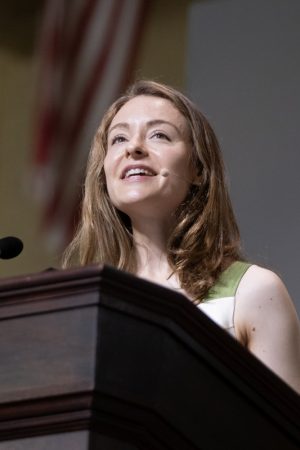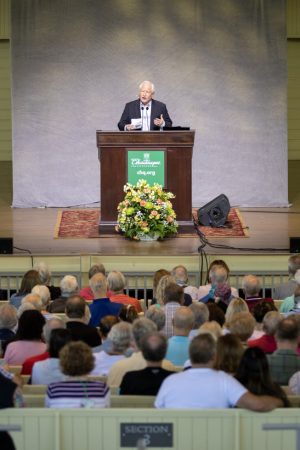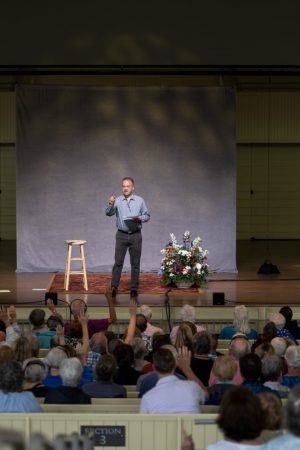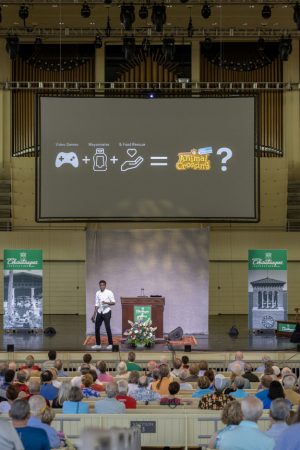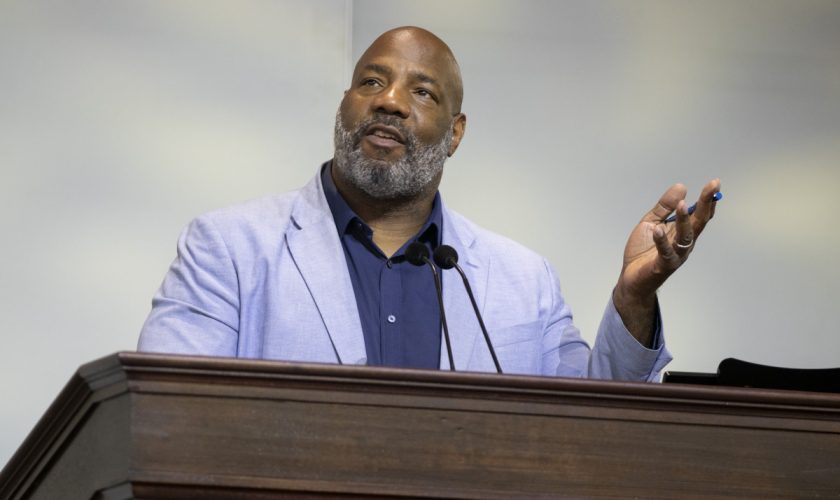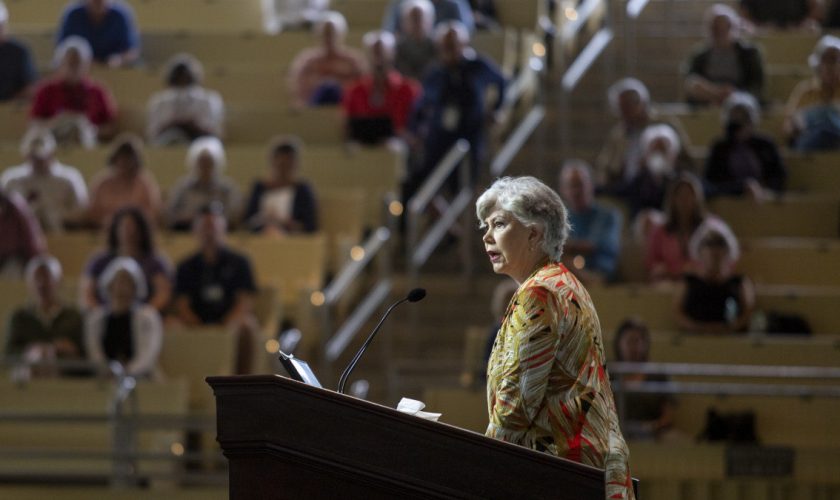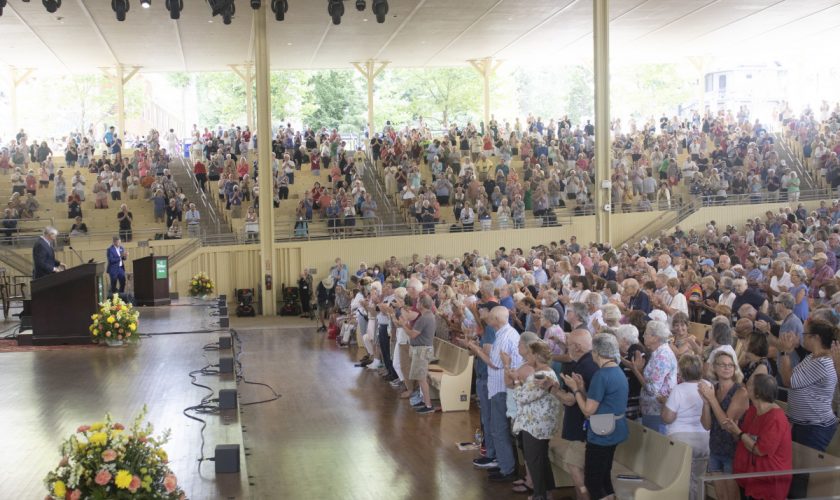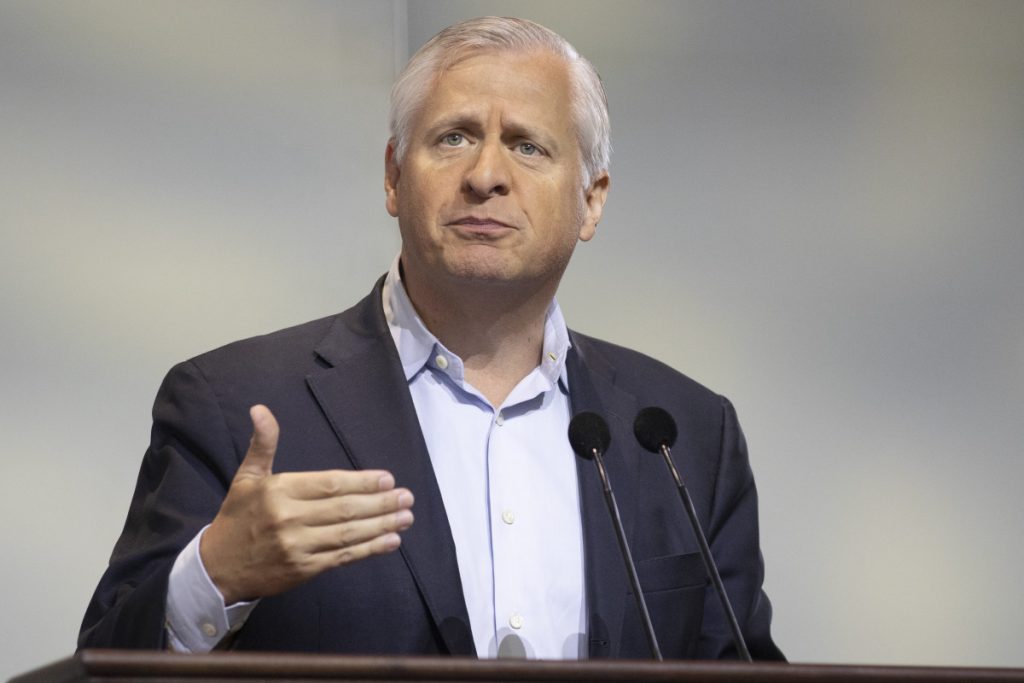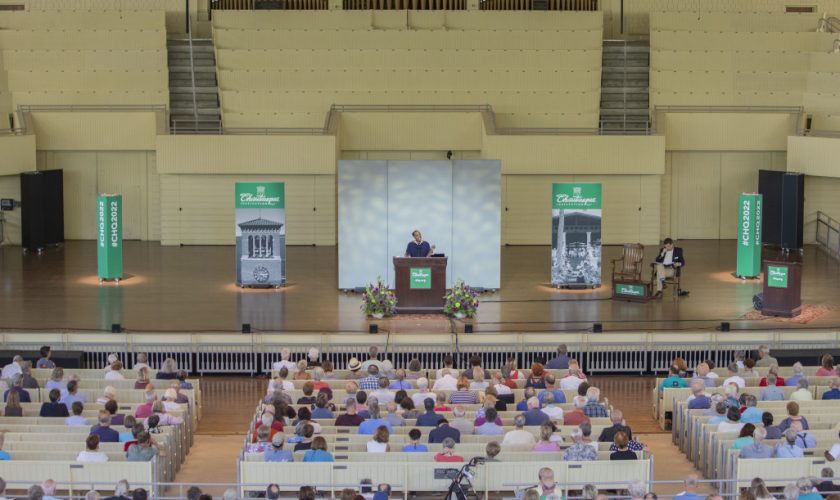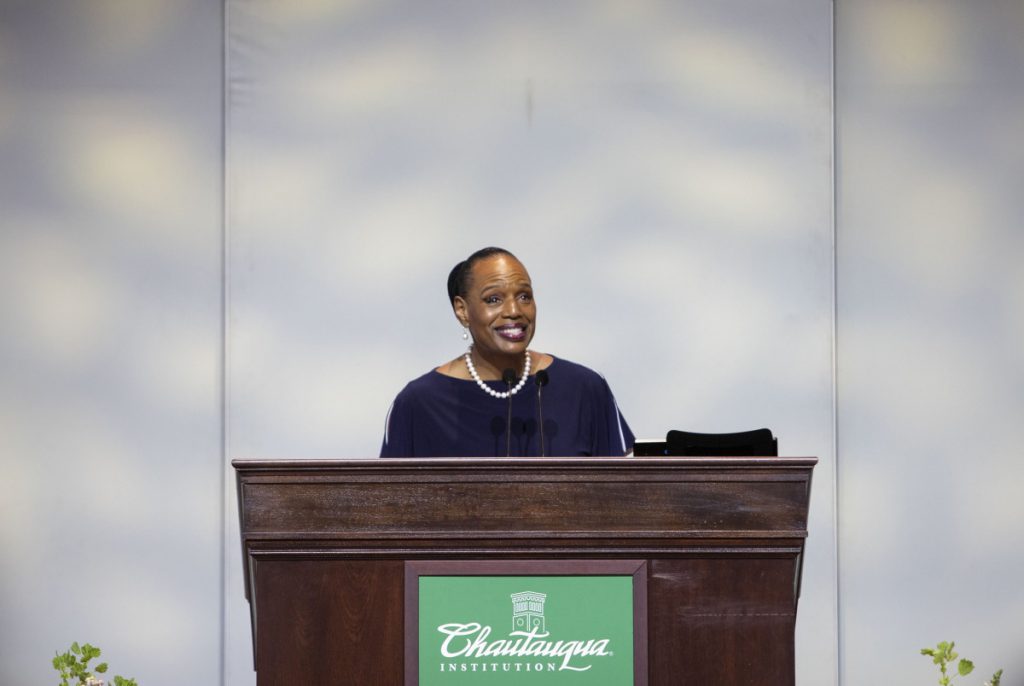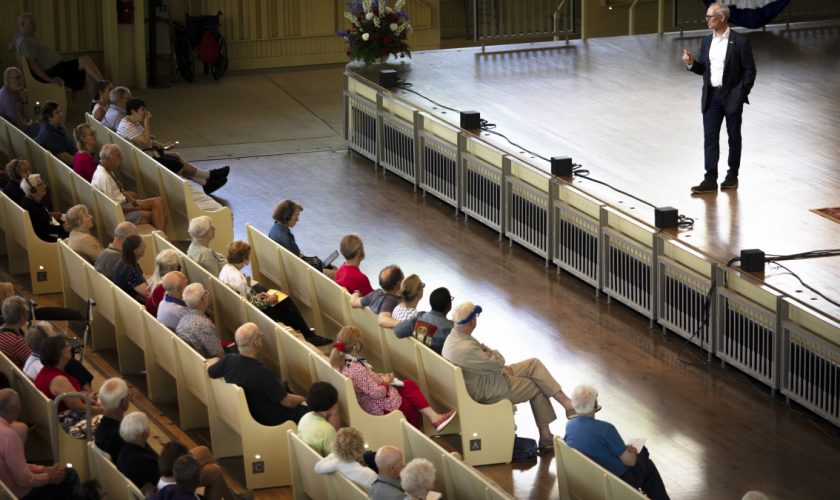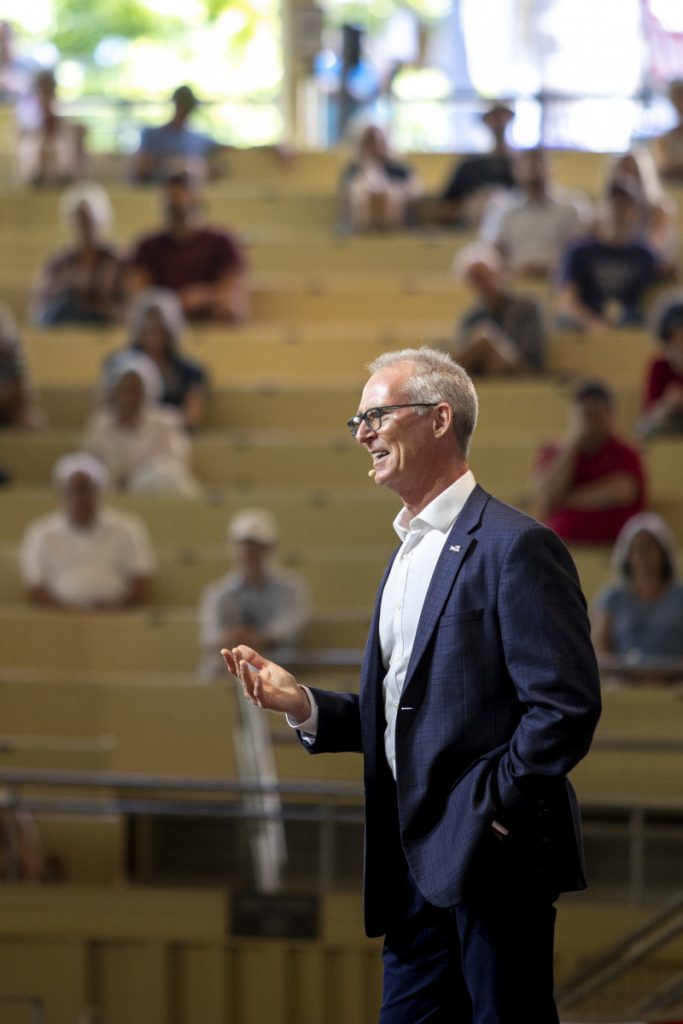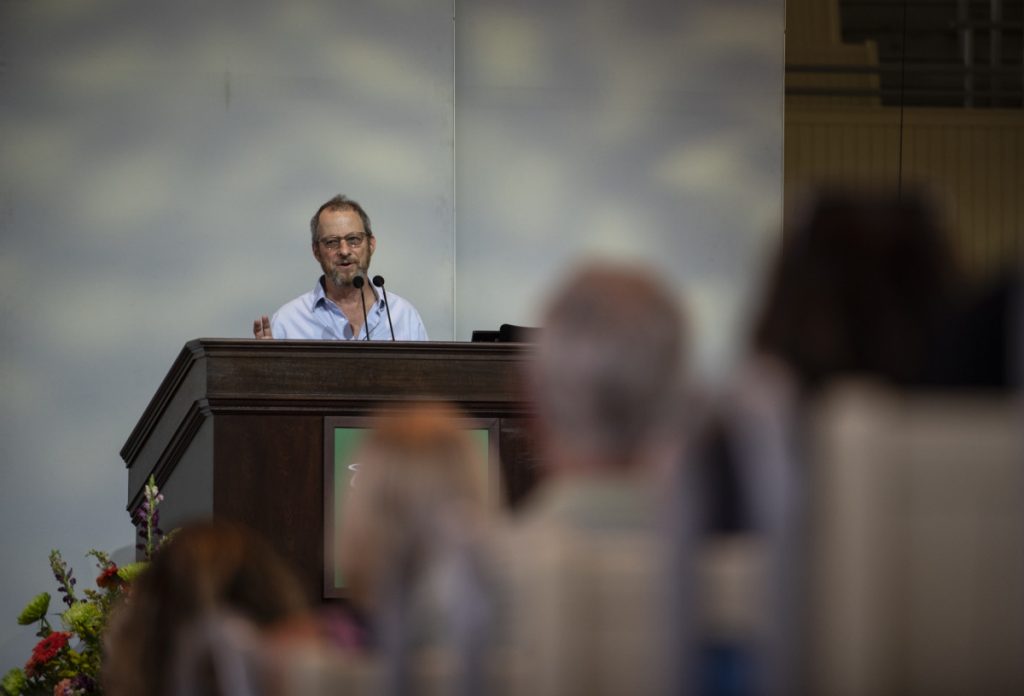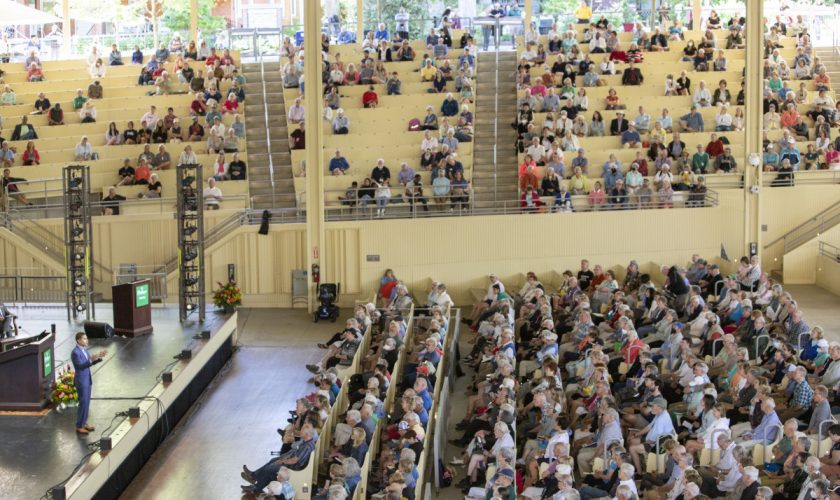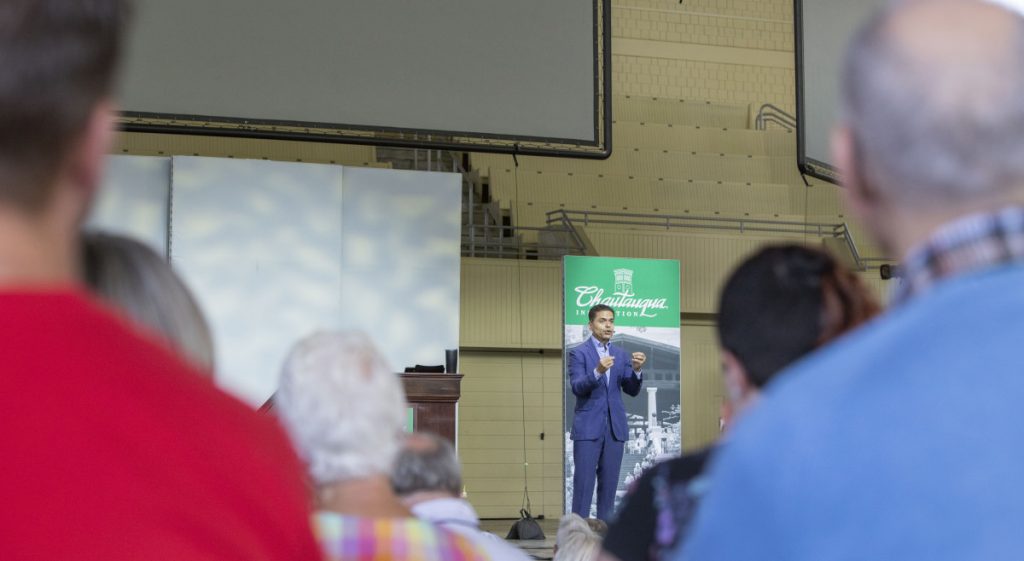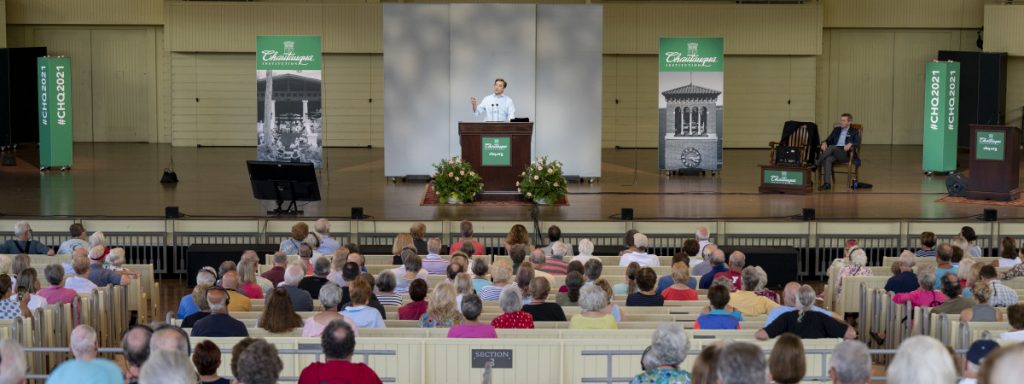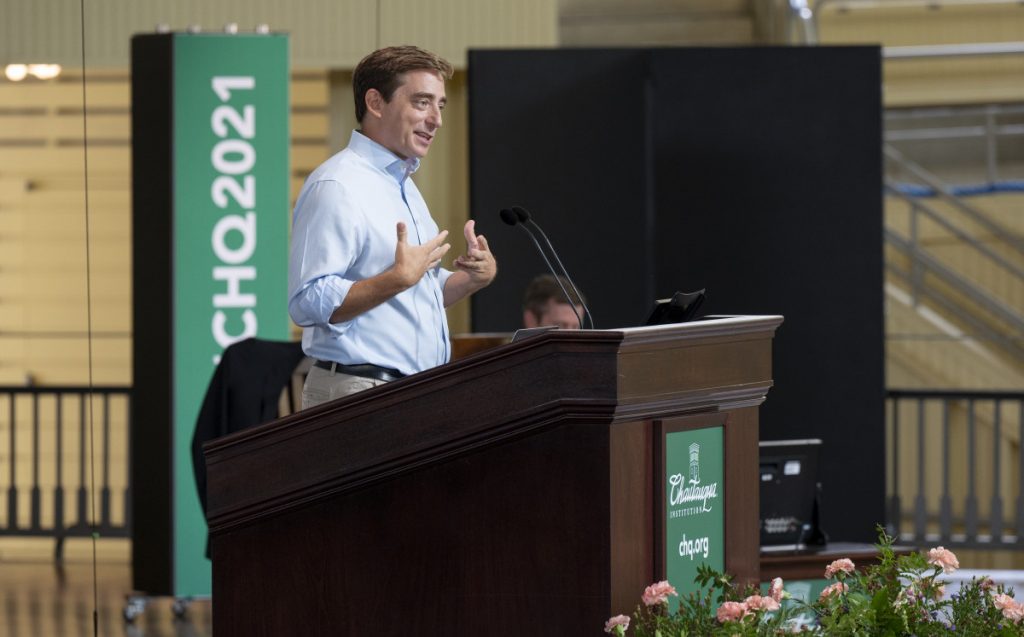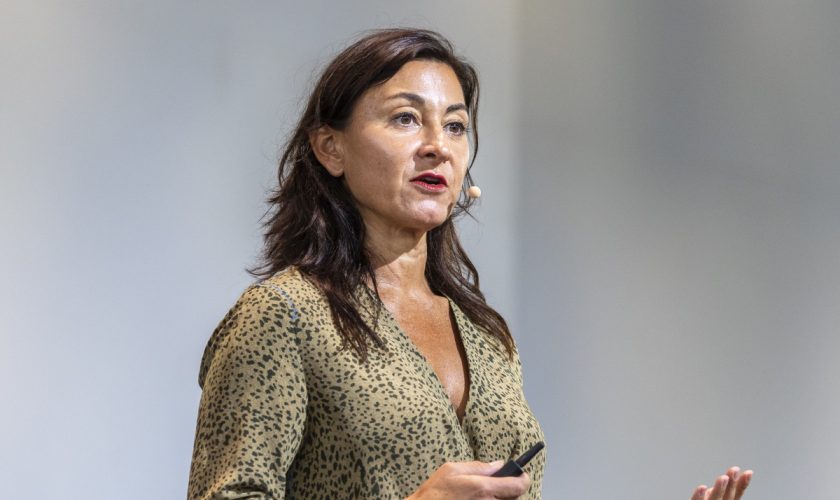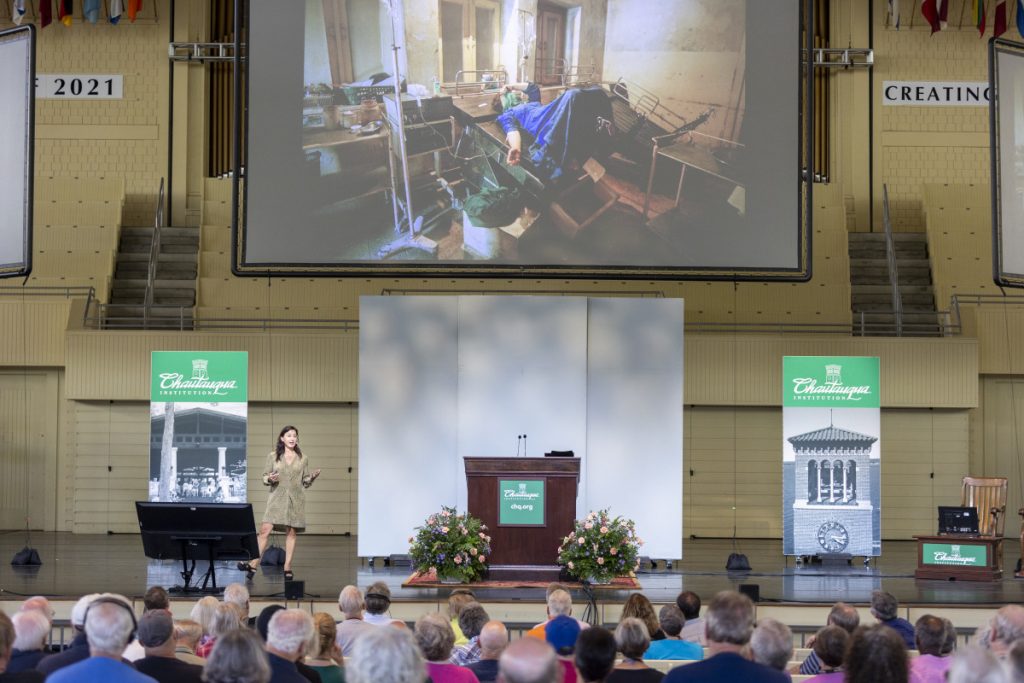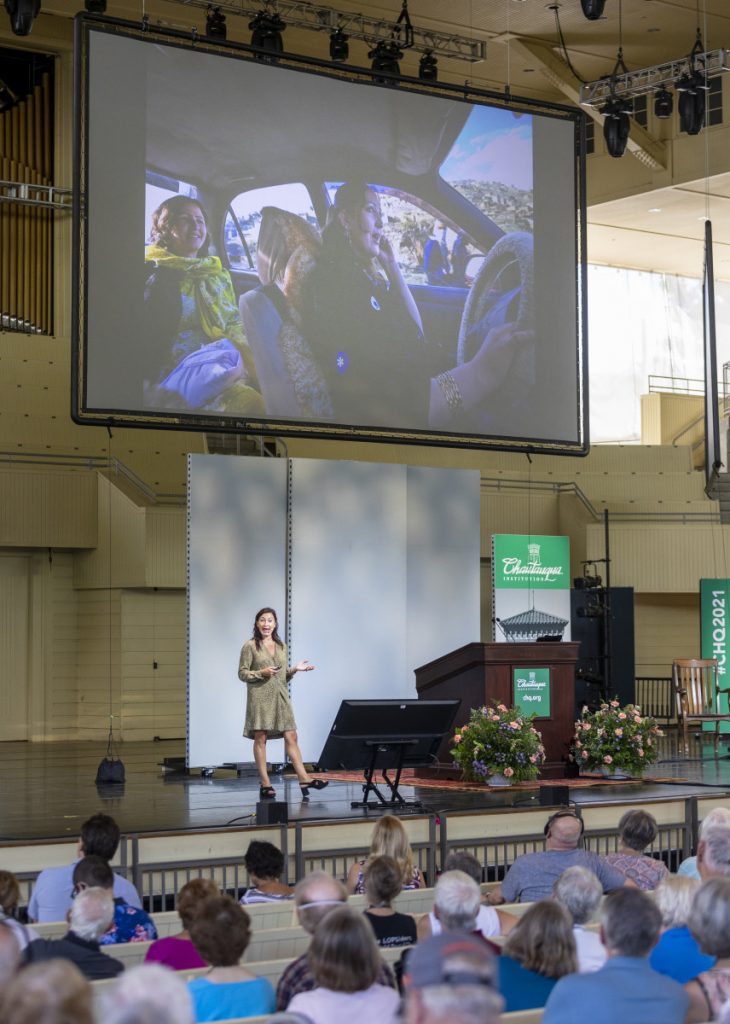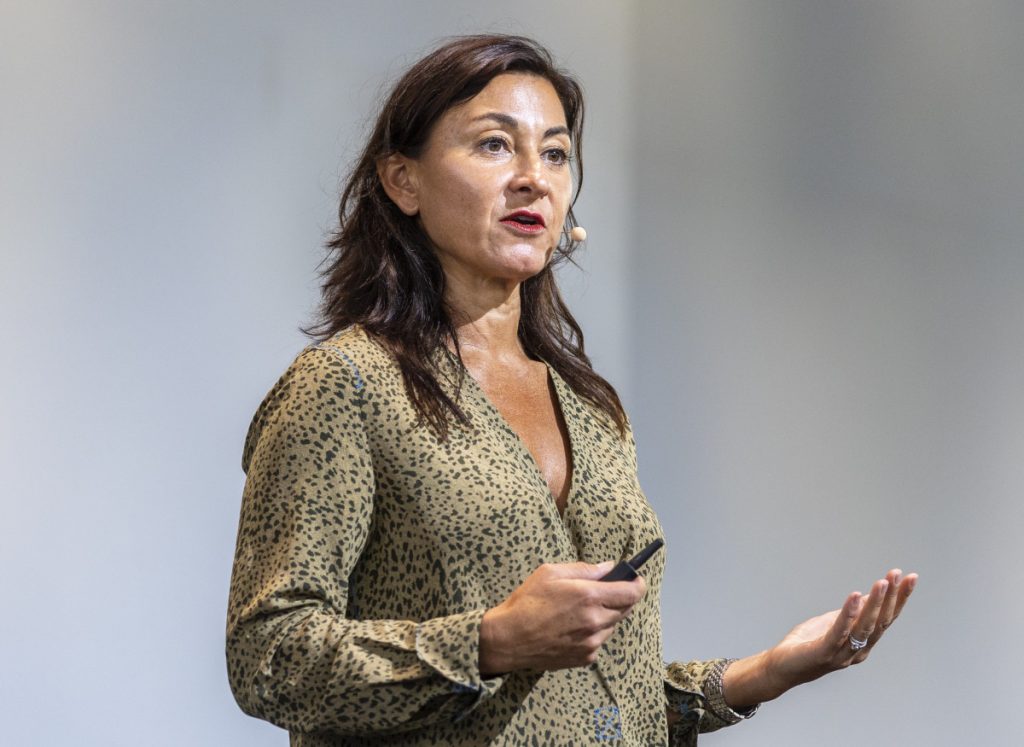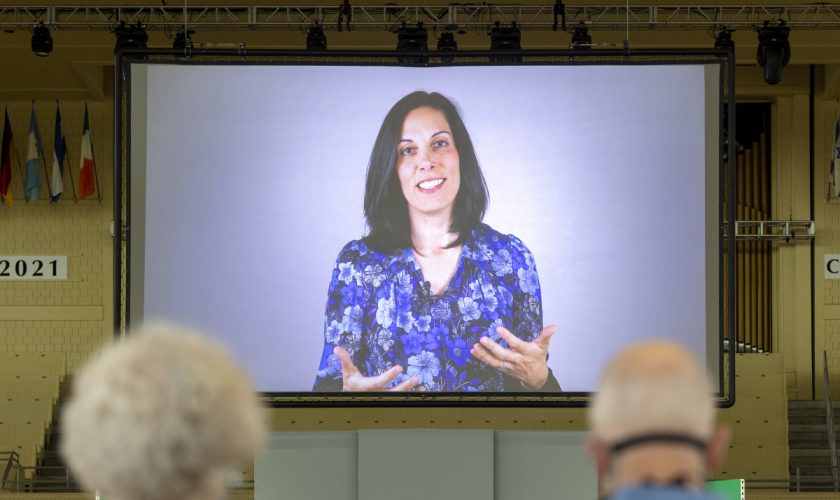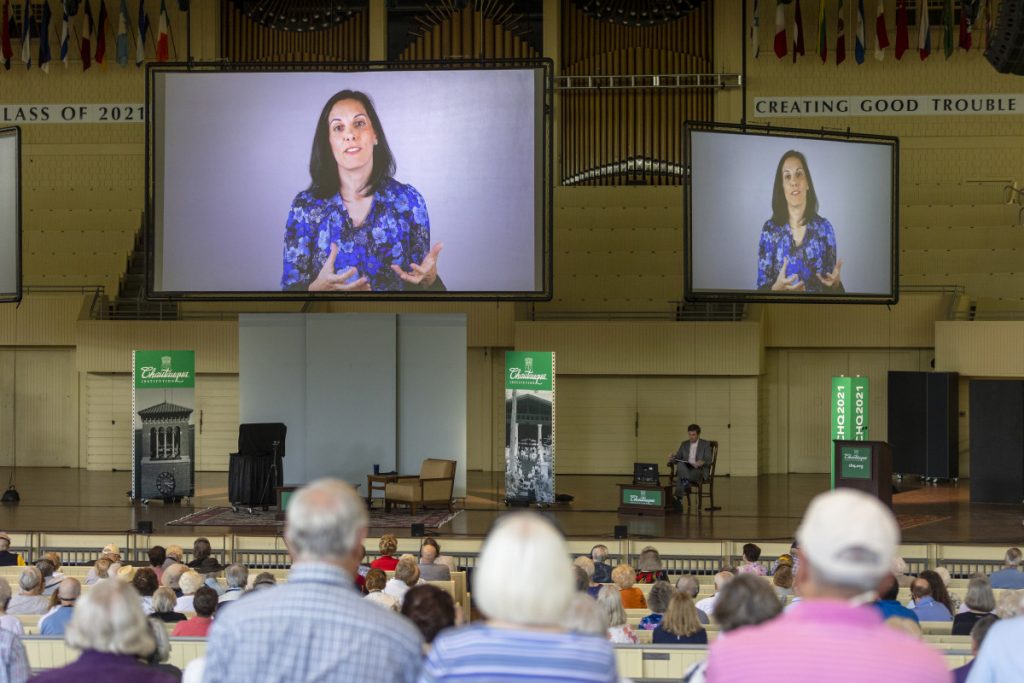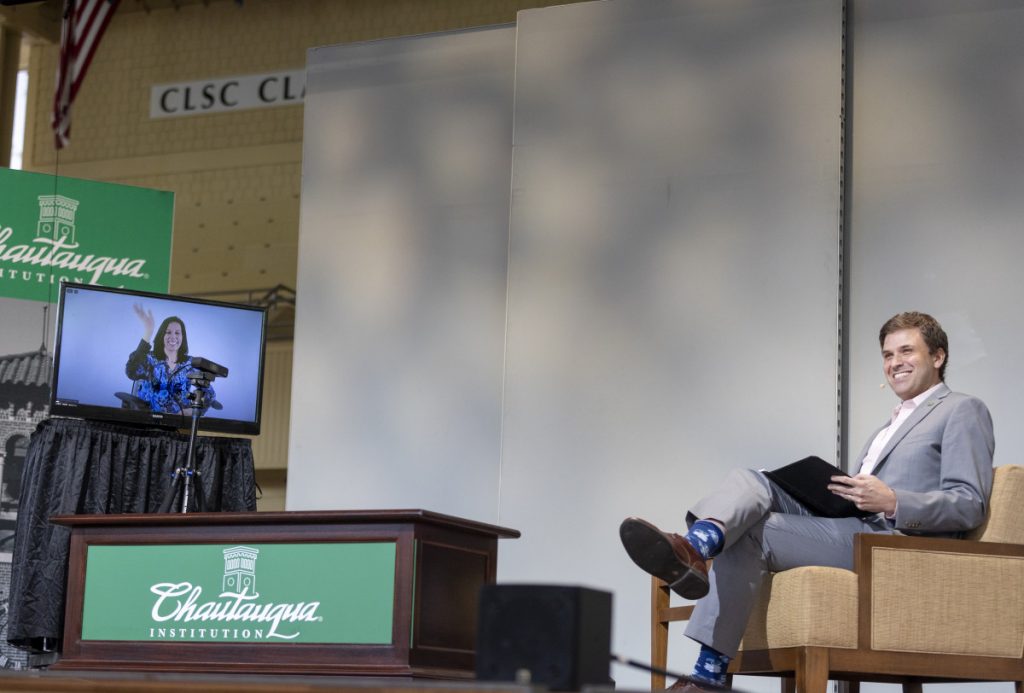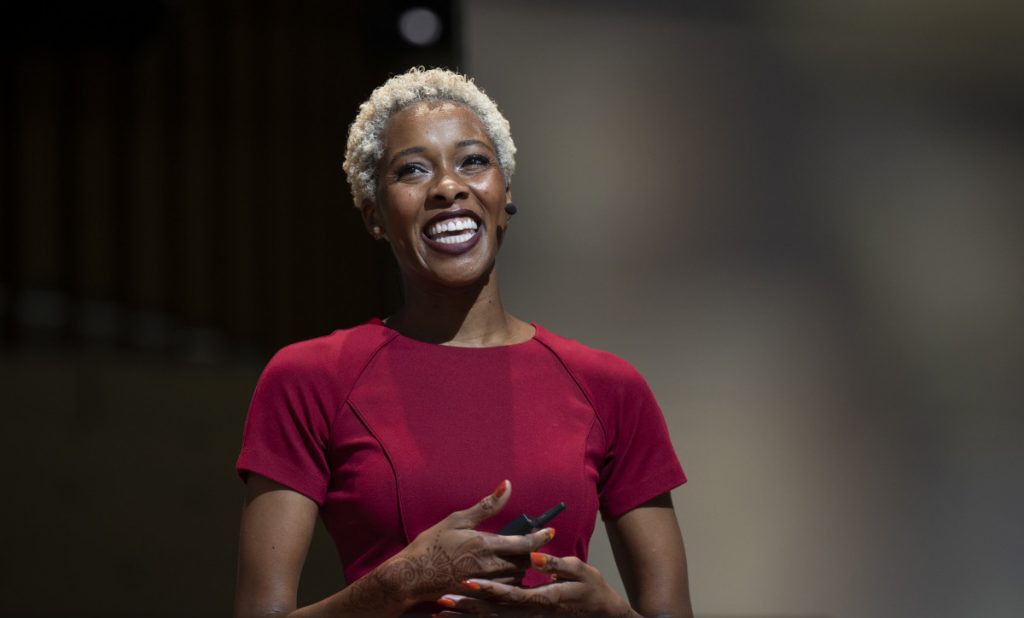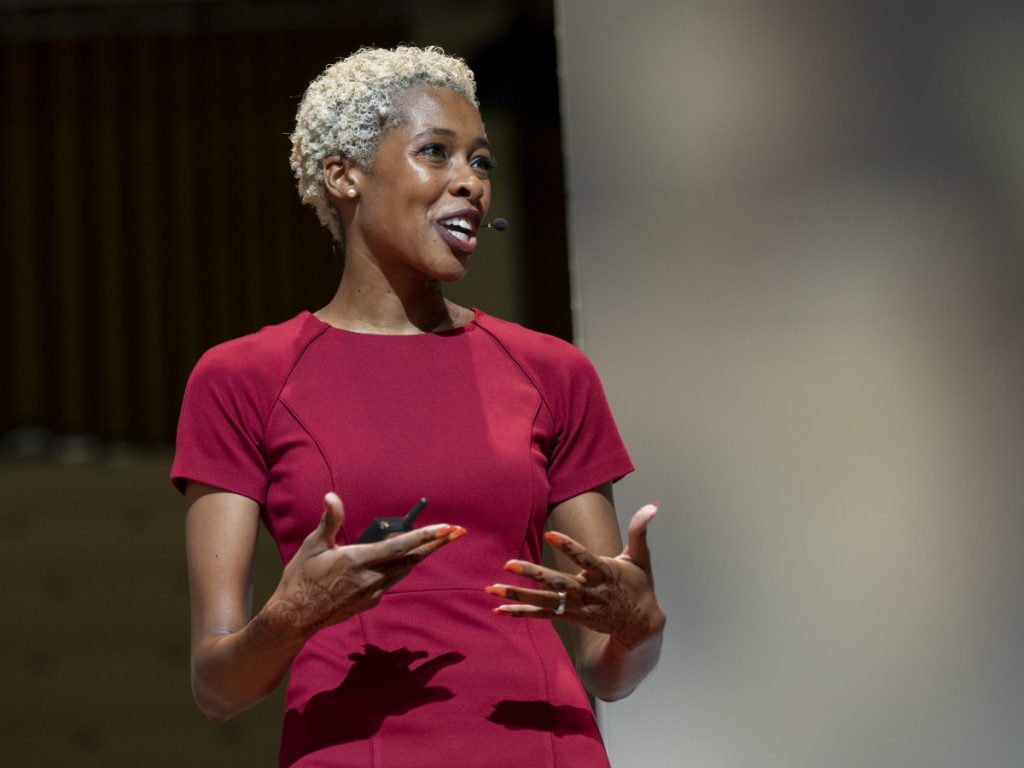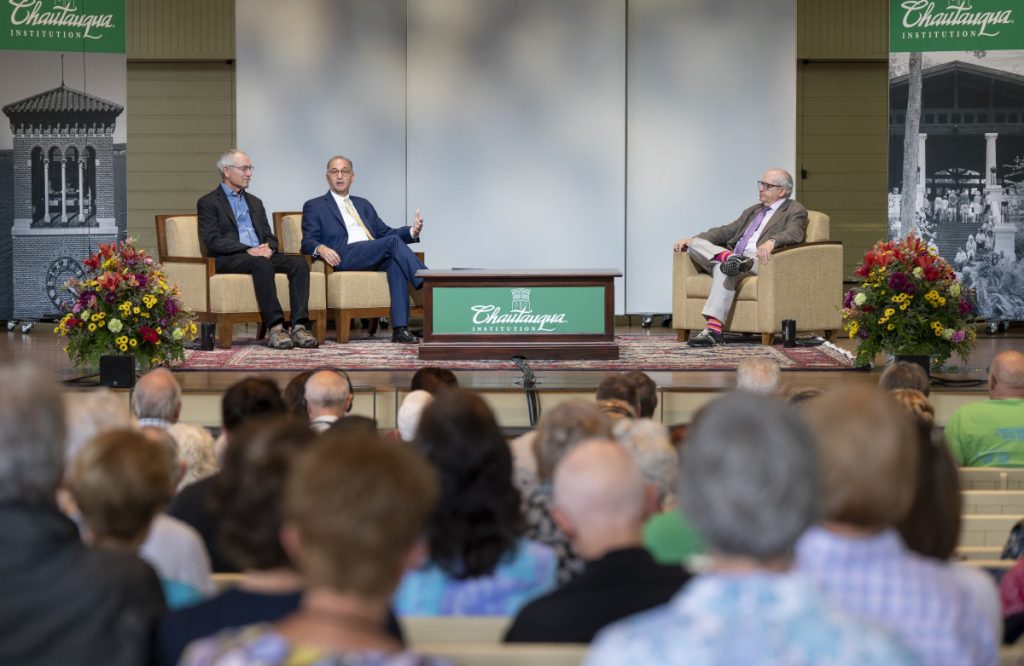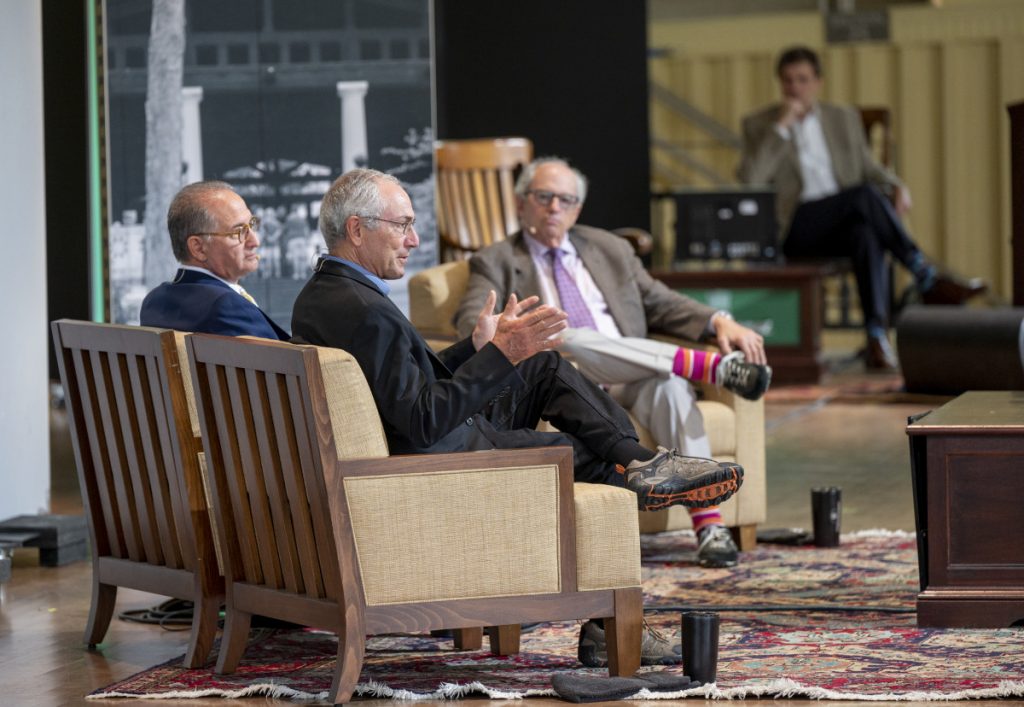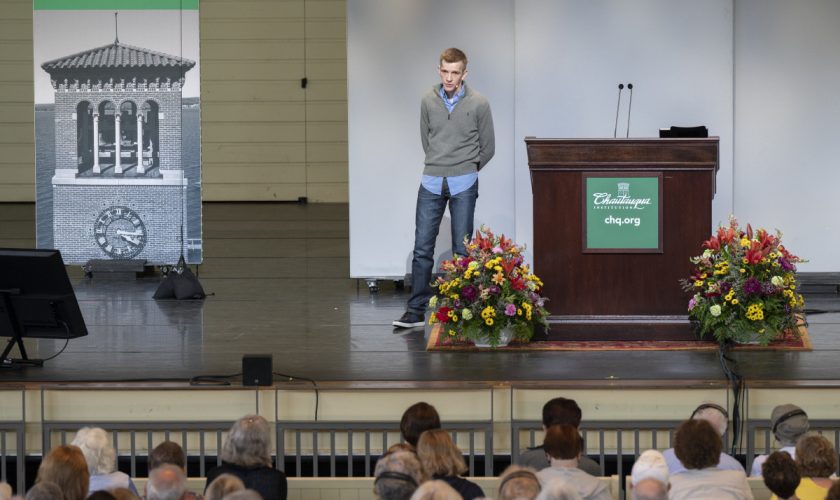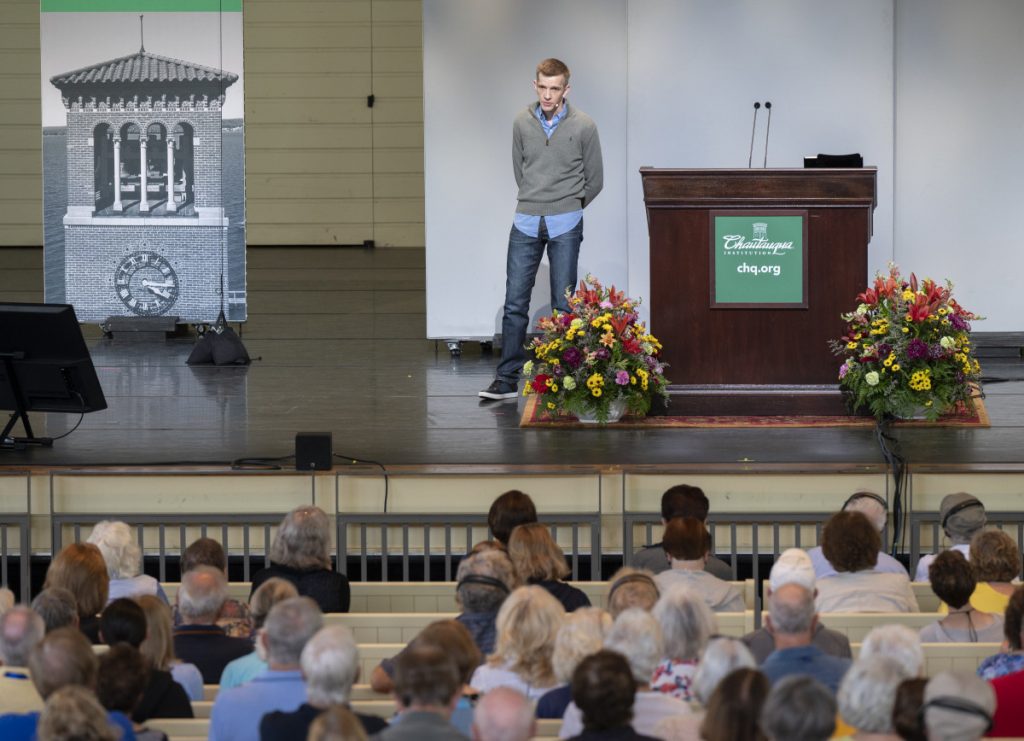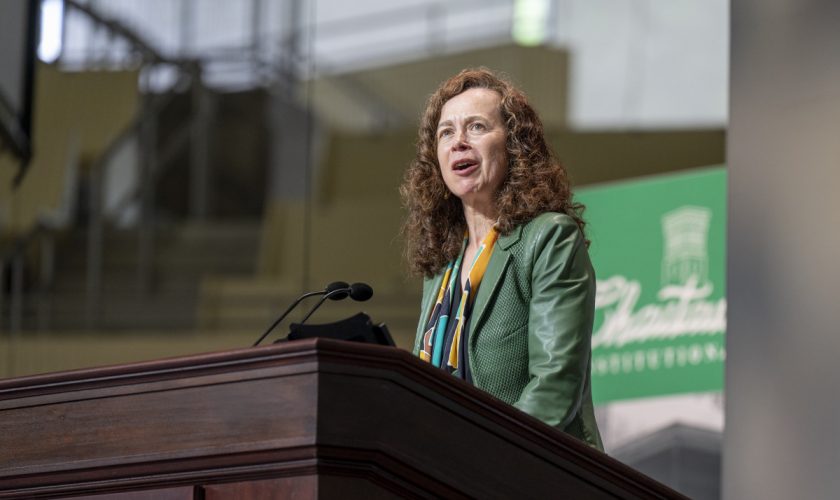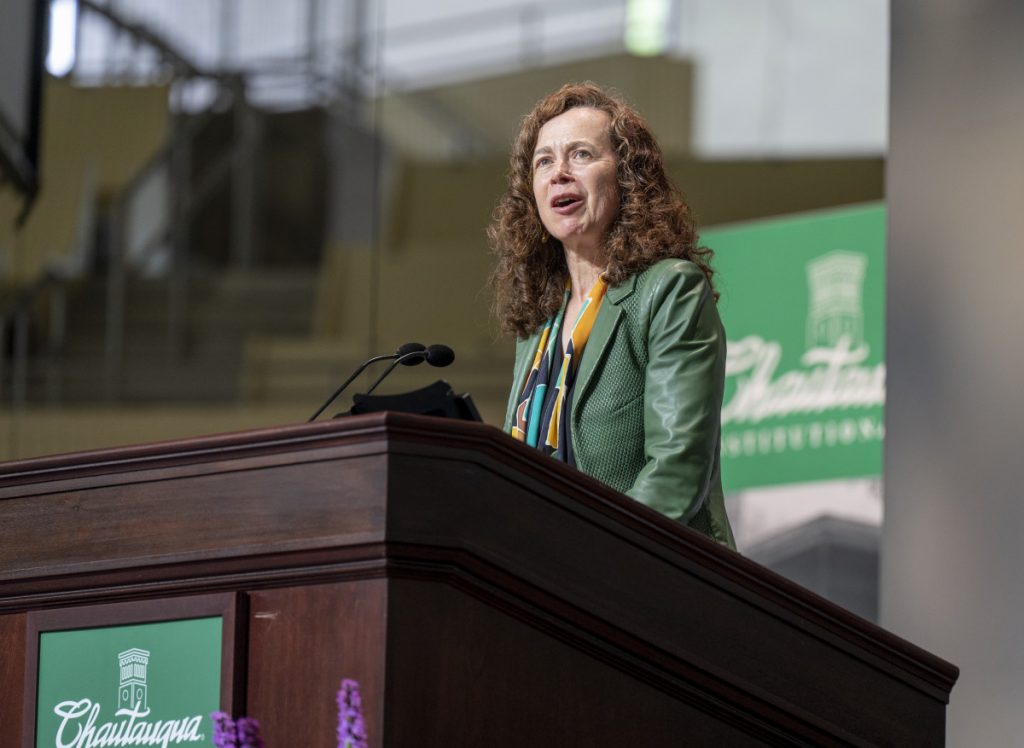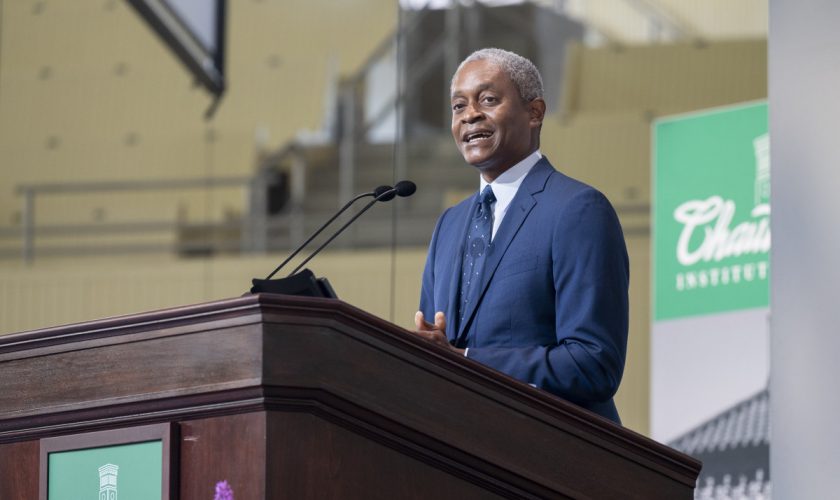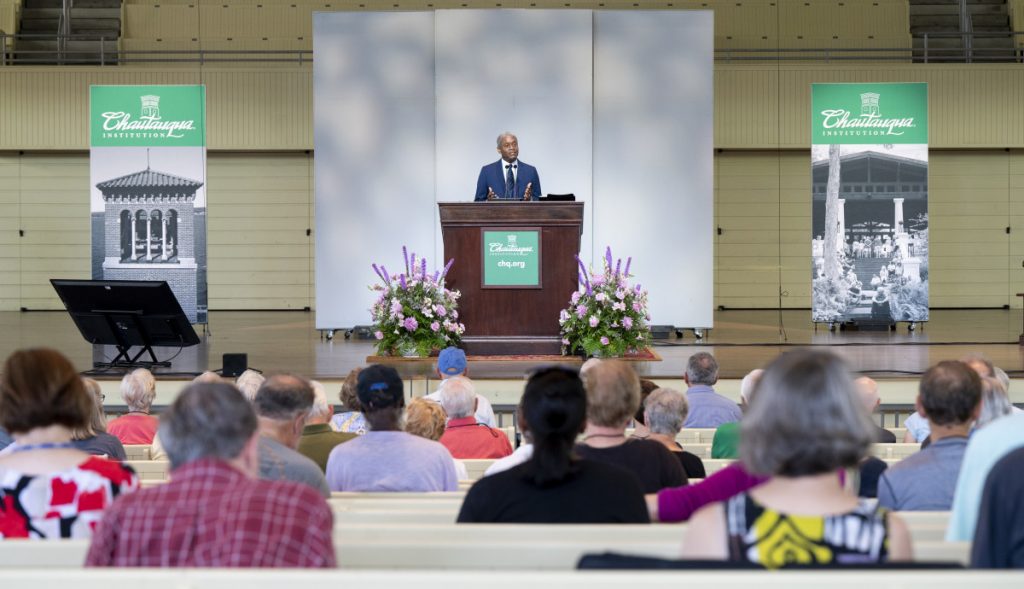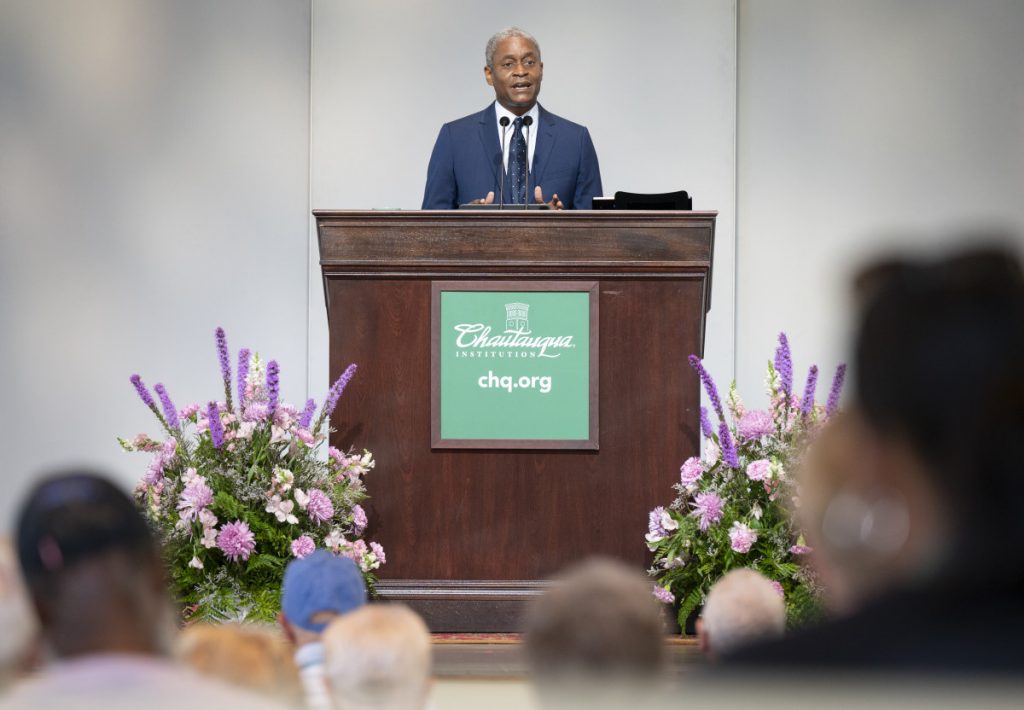Right off the bat, American democracy is not playing the same softball game it was back in 1776, as Jelani Cobb, historian, Peabody Award winner, incoming dean of Columbia Journalism School and staff writer for The New Yorker outlined in his lecture at 10:45 a.m. Wednesday, July 27, in the Amphitheater as part of the Chautauqua Lecture Series.
Speaking to the theme of “The Vote and Democracy,” Cobb opened his lecture with a few sports metaphors and questions, asking the audience if they remember the first time they played softball or baseball, or boxed, against a left-handed person.
Cobb, a southpaw himself, said the fundamentals of sports are fairly easy to learn until going up against a left-handed person. Then everything that was up was down, Cobb said, and he takes a particular pride in hearing right-handed people groan at this experience.
“All the rules you learned that apply in one way is the exact opposite that you have to do when you play against a left-handed person,” Cobb said. “Our society, our institution, the fundamental bulwarks of our democracy are playing against a left-hander for the first time.”
America is attempting to understand the patterns, policies and behaviors that are the inverse of the practices that originally led to a fully functioning democracy. Cobb highlighted the events of Jan. 6, 2021, as an example of this, along with the subsequent investigation and hearing.
“It’s possible amid the crush of information that we encounter in any given day, and the speed of events locally, nationally, internationally, globally, it’s possible to lose sight of just how astounding a departure the events of Jan. 6, 2021, were,” Cobb said.
George Washington is the only non-partisan president America has had. Federalist John Adams term ended and in 1800 Thomas Jefferson entered as a Democratic Republican, and for the next 220 years there was a “chain of peaceful transfers of powers.”
Cobb’s first foundational memory is his father taking him along to vote in the 1976 presidential election when he was 6. At first, he didn’t realize why his father took him, but he recognized later on that his father wanted “to instill in me at an early age the importance of not only exercising the right to the franchise, but the importance of having the rights to the franchise.”
If his father attempted to vote in his youth, in his home state of Georgia, he would have been subject to severe injuries, even death. President Lyndon B. Johnson signed the 1965 Voting Rights Act into law when there were about 1,000 African Americans who held office in the United States. Cobb said this number has massively increased since then.
Eight weeks after Johnson signed the Voting Rights Act into law, he signed the Immigration and Nationality Act — also known as the Hart-Celler Act — into law, voiding the quota system. The quota system, created through the Immigration Act of 1924, was a xenophobic reaction in an attempt to preserve U.S. homogeneity. It favored northern and Western European immigrants, while essentially ending all immigration from Asian countries.
“What that did was strip away the old racist quota system. … That’s not my judgment, that was the judgment of the people who wrote the law,” Cobb said.
With the Hart-Cellar Act, immigration began to increase from countries outside of northern and Western Europe.
“We began to see immigration from places like India and Latin America, the Caribbean, Africa — places people would have had a great difficulty coming into this country as immigrants prior to this,” Cobb said.
The reverberation has echoed throughout America ever since these laws were passed, but Cobb said to understand how “potent this idea of maintaining a largely white electorate has been,” people need to dive even further back in American history.
“If we go back to 1798 in the course of the undeclared war that the United States was fighting with France, President John Adams and the federalists were also keeping an eye on Thomas Jefferson,” Cobb said, “who they thought would be formidable in the election of 1800. And they passed a law called the Alien Act of 1978.”
The principles attached to this policy, formally known as the Alien and Sedition Acts, changed the five years of residency necessary to become a citizen to 14 years of U.S. residency. In response to this, Cobb said Jefferson and Madison were so furious they drafted two propositions called interposition and nullification, otherwise known as state’s rights.
“(Jefferson and Madison) argue that states have the right to nullify legislation that imposes on the rights of their citizens,” Cobb said. “The federalists know that Thomas Jefferson is particularly popular with immigrant voters, and that if they can prevent more people from becoming eligible voters, they may have a chance of preventing him from becoming the next president.”
Then, in 1800, Jefferson won the election and Cobb said there is a “peaceful transition of power, and we move on.” Cobb said politics played out similarly over the course of the 19th century, but then from 1861 to 1865, almost 700,000 people died in the Civil War.
“About 12 times the number of Americans who died in Vietnam. Almost double the number of Americans who died in World War II,” Cobb said. “By far our bloodiest conflict, fought over the questions of ‘Who will belong?’ ‘Who qualifies as a human being?’ Will it be possible?’ and ‘’Will it be legal to own other human beings?’ ”
All of these questions were resolved by the 13th Amendment’s abolition of slavery. The Emancipation Proclamation struck down slavery, and Cobb said Abraham Lincoln and the Republican Party had one overriding concern.
“The Confederates largely centered on, at that time in the Democratic Party, not being able to regain the level of political power they had prior to the war,” Cobb said.
That power came from the Three-fifths Compromise, which counted each enslaved person as three-fifths of a vote in a congressional apportionment. Cobb said this allowed white, Southern slave owners to have a disproportionate amount of power, and Republicans were “concerned if they ever regain the level of power they had in 1860, they will rip the country in half again.”
Before Lincoln’s assassination in 1865, he pondered the situation, but never came to a conclusion. Lincoln was trying to figure out how to give the vote to formerly enslaved men, something he had opposed seven years prior in debates with Stephen A. Douglas.
“He reasons, correctly, that if Black people are given the right to vote, they are not going to vote for the candidates who also get the support of their former slave masters,” Cobb said. “They will vote for the Republican Party — that Black people will be a counter balance to the power of the white Confederacy.”
After Lincoln’s assassination, the 15th Amendment was ratified, giving the right to vote to all men, but not women. Due to the amount of white men who died in the Civil War though, there were more white women in the South than men.
“An astounding change takes place in American politics (and) in American government,” Cobb said. “Within a few short years, we see more than 600 African Americans, many of them former slaves, elected to political office throughout the South.”
Cobb said these political figures sought progressive change right away, but these rights were swept away as quickly as they came due to Jim Crow laws and segregation over the next 100 years. In March 1965, at the conclusion of the march from Selma to Montgomery, Alabama, Martin Luther King Jr. delivered a speech.
“It’s not one of his better-known speeches, but it is one of his most fascinating and insightful,” Cobb said. “He gives a speech explaining why they had to fight for the right to vote in 1965, almost a full century after the 15th Amendment had granted the right to vote to African Americans.”
In this speech, King talked about the counter-revolution that reinforced the laws that catered to the wealthy, white slave owners. This is when America saw lynching, violence, intimidation and other “blatantly unconstitutional” acts against Black people.
“In response, the Southerner Lyndon B. Johnson gives a speech, which he concludes with the words ‘We shall overcome,’ and announces he will sign voting rights legislation,” Cobb said. “That happened in 1965. Five months later, President Johnson signs that legislation (and) it has this momentous impact.”
Over the years, the alignment between voter rights and immigration has become more explicit, Cobb said. The Voting Rights Act was focused solely on enfranchising Black Americans, but over the course of history amendments have been added to protect Indigenous people.
Language barriers are also an issue that has been addressed, Cobb said; the language minority provisions of the Voting Rights Act say that if over 1% of the population speaks any one language, the voting centers have to provide valid materials available in that language.
“An example of this is, in the last mayoral election in New York City, I took my daughter with me,” Cobb said. “My daughter is just about the age I was when my father took me to vote in that presidential election.”
Reaching this full circle moment, Cobb took his daughter through every step of his personal voting process. He told her why he made certain decisions, who he was going to vote for and why.
“I let her cast the ballot, and then I took her for candy,” Cobb said. “I’m old enough to have realized that some portion of good parenting involves manipulation.”
Over time, the Voting Rights Act “grows to become a fundamental bulwark of inclusion in American democracy,” Cobb said, “but there are two dynamics that change the course of this.”
“This first happens in 2008 with the stunning, really unpredictable rise and election of the first Black president of the United States,” Cobb said.
Although electing Barack Obama as president in 2008 was a huge milestone, Cobb said the fight for equal voting rights is never-ending.
Cobb once interviewed former Attorney General Eric H. Holder Jr. about Shelby County v. Holder, and the decision that the Voting Rights Act places an unfair burden on Southern States — specifically with regard to the mandate that historically discriminatory jurisdictions receive court approval before changing any voting procedures.
“Never mind the fact that there had been Southern counties … which had as recently as a few years earlier had laws struck down for disproportionately disadvantaging Black voters,” Cobb said.
Now, there is legislation preventing voter fraud, which makes it harder for people, mainly minorities, in particular counties to vote, he said. The rise of voter ID requirements and changing voter procedures, including how long people have to wait to vote, are examples of this; Cobb saw this firsthand.
“I lived in Georgia during these years,” Cobb said. “I remember witnessing the lengthening lines in communities where you would go out and vote.”
Cobb then pivoted to more recent events, including Donald Trump’s presidential election in 2016. Trump famously said that he lost the popular vote because between 3 and 5 million people — whom he referred to as illegal immigrants — had voted in the state of California.
“It was specifically a canard that frightened people with the prospect that 3 to 5 million people not in the country legally insinuated themselves into the electorate, playing into that antique American fear,” Cobb said.
Yet voter fraud is rare, he said, and hardly enough to justify the impositions of the regime alleging there is no more voter fraud.
“I was covering a story about an election, and one of the things you find about covering local politics … is that the lower you go on the political scale, the less elegant the lies people tell you,” Cobb said.
Cobb said the landscape America finds itself in is one of weaponized lies, with the ability to mobilize people, citing the Jan. 6 Capitol riots. He said the Capitol has a particular metaphorical history.
“We know it was constructed in part by slave labor, but the original dome of the Capitol, which was made of wood, rotted immediately and over the course of the Civil War,” Cobb said. “Abraham Lincoln’s government oversaw the reconstruction of the Capitol dome, and that reconstruction became a metaphor for the attempt to hold the country together.”
The opposite metaphor was witnessed Jan. 6, 2021, when thousands of protesters broke through and stormed the Capitol.
“This is a dire crisis,” he said. “So what do we do here?”
Cobb said two key pieces of legislation — the Save Democracy Act and the John Lewis Voting Rights Advancement Act — are stalled in the Senate because of the refusal of Senators Joe Manchin and Kyrsten Sinema to reform the filibuster.
“So it falls to us. It falls to us to pressure people,” Cobb said. “It falls to us to support candidates who are in favor of protecting American democracy.”
To close his lecture, Cobb gave a synopsis of the November 2020 election and the role the country thought Georgia was going to play, but didn’t. Now, Black voters are being asked to do exactly what the Republican Party asked Black voters to do in 1870: Nullify the threat of white supremacy destroying democracy.
“That is the responsibility that confront us. That is the work that is in our hands,” Cobb said. “It’s our responsibility to ensure that this country continues to move as diligently as possible in the direction of democracy, not autocracy. History is watching.”

